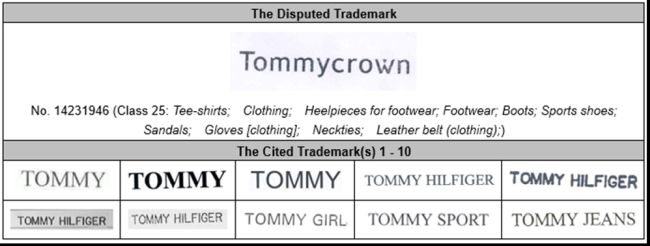Recently, the Beijing High People's Court ruled an invalidation case which confirmed the invalidation against the trademark "Tommycrown" based on its similarity with Tommy Hilfiger.
The disputed mark No.14231946 for "Tommycrown" was originally filed by "Yueqing Funaide Rubber & Plastic Co., Ltd." on March 24, 2014 and registered on May 7, 2015 covering the goods in class 25 of "Tee-shirts; Clothing; Heelpieces for footwear; Footwear; Boots; Sports shoes; Sandals; Gloves [clothing]; Neckties; Leather belt (clothing);". Later, this mark was transferred to its current owner "TOMMY CROWN(U.K.) INTERNATIONAL FASHION CO., LTD" (hereafter "TOMMY CROWN") in 2018.

TOMMY HILFIGER LICENSING B.V. (hereafter "TOMMY HILFIGER") filed an invalidation against this disputed mark since 2018. First, both the China National Intellectual Property Administration ("CNIPA") and Beijing IP Court confirmed the similarity between the disputed mark and cited marks, thus invalidated the disputed mark. Nevertheless, TOMMY CROWN further appealed to the Beijing High People's Court.
After examining the case, the Beijing High People's Court held that:
- The disputed mark and the cited marks 1- 10 all contain the letters "TOMMY", which are similar in terms of letter composition and pronunciation.
- The evidence in the case can prove that "TOMMY HILFGER" has enjoyed a certain reputation before the application of disputed mark. Under this circumstance, TOMMY CROWN still filed the disputed mark which is highly similar to the cited marks. Failure to avoid others' prior trademarks that have a certain degree of popularity can hardly be considered good faith.
In view of this, the coexistence of the disputed mark and the cited marks on similar goods will cause confusion and misunderstanding on the goods origin by related consumers. The disputed mark and cited marks have constituted similar trademarks used on the same or similar goods as stipulated in Article 30 of the Trademark Law, thus the disputed mark shall be declared invalid.
Article 30 of Trademark Law: Where a trademark to be applied for registration is in nonconformity with the relevant provisions of the Law, or it is identical with or similar to the trademark of another person that has, in respect of the same or similar goods, been registered or preliminarily approved, the Trademark Office shall refuse the application without announcement.
Comments
The judgment of trademark similarity is always a key issue in trademark cases. The different backgrounds of the cases often lead to different judgment results.
In the captioned decision, the Beijing High People's Court pointed out that in determining whether the disputed mark is registrable, it is necessary to comprehensively consider below factors and the interaction between these factors, and based on whether it is easy to create confusion for the relevant public.
- the similar degree of marks of the trademarks and the goods
- the distinctiveness and popularity of the reference trademark,
- the degree of attention of the relevant public
- the subjective intention of the applicant of the trademark in dispute
If the whole of cited trademark or its distinctive identification part is taken as a component of the trademark in dispute, these trademarks may be determined to have similar marks.
In fact, the basis of the above judgment comes from "Beijing High People's Court Guidelines for the Trial of Trademark Right Granting and Verification Cases" issued in 2019. It is also an important reference basis for the application of Article 30 of Chinese Trademark Law (judgment of similarity).
In practice, in most trademark invalidation cases, evidence of popularity of the cited mark and evidence of malicious registration of the disputed trademark are suggested to actively collect and submit, which can affect the judgment of similarity based on comprehensively consideration of different factors.
The content of this article is intended to provide a general guide to the subject matter. Specialist advice should be sought about your specific circumstances.


